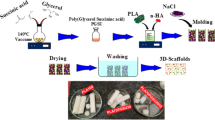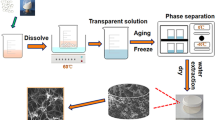Abstract
Biodegradable polymer/bioceramic composite scaffolds can overcome the limitations of conventional ceramic bone substitutes such as brittleness and difficulty in shaping. However, conventional methods for fabricating polymer/bioceramic composite scaffolds often use organic solvents (e.g., the solvent casting and particulate leaching (SC/PL) method), which might be harmful to cells or tissues. In this study, Poly (d,l-lactide)/nano-hydroxyapatite (PDLLA/NHA) composites were prepared by in-situ polymerization, and highly porous scaffolds were fabricated using a novel method, supercritical CO2/salt-leaching method (SC CO2/SL). The materials and scaffolds were investigated by scanning electronic microscopy (SEM), transmission electronic microscopy (TEM) and gel permeation chromatography (GPC). GPC showed that the molecular weight of composites decreased with increase of NHA content. However, the water absorption and compressive strength increased dramatically. The SEM micrographs showed that the scaffolds with pore size about 250 μm were obtained by controlling parameters of SC CO2/SL. The biocompatibility of PDLLA/NHA porous scaffolds were evaluated in vitro and in vivo. The evaluation on the cytotoxicity were carried out by cell relative growth rate (RGR) method and cell direct contact method. The cytotoxicity of these scaffolds was in grade I according to ISO 10993-1. There was no toxicosis and death cases observed in acute systemic toxicity test. And histological observation of the tissue response (1 and 9 weeks after the implantation) showed that there are still some slight inflammation responses.









Similar content being viewed by others
References
F. R. A. J. ROSE and R. O. C. OREFFO, Biochem. Biophys. Res. Comm. 292 (2002) 1
R. F. SERVICE, Science 289 (2000) 1498
J. R. JONES and L. L. HENCH, Mater. Sci. Technol. 17 (2001) 891
R. LANGER and J. P. VACANTI, Tissue Eng. Sci. 260 (1993) 920
Y. TABATA, Drug Discov. Today 6 (2001) 483
A. DENUZIERE, D. FERRIER, O. DAMOUR et al., Biomaterials 19 (1998) 1275
R. K. KULKARNI, K. C. PANI, C. NEUMAN et al., Arch. Surg. 93 (1966) 839
D. E. CUTRIGHT and E. E. HUNSUCK, Oral Surg. Oral Med. Oral Pathol. 31 (1971) 134
A. MAJOLA, S. VAINIONAPAA, K. VIHTONEN et al., Clin. Orthop. Relat. Res. 268 (1991) 260
S. L. SHAUG, G. M. CRANE, M. J. MILLER et al., J. Biomed. Mater. Res. 36 (1997) 17
T. B. REN, J. REN, K. F. PAN et al., J. Biomed. Mater. Res. Part A. 74 (2005) 562
L. G. GRIFFITH, Acta. Mater. 48 (2000) 263
C. M. AGRAWAL and R. B. RAY, J. Biomed. Mater. Res. 55 (2001) 141
Y. SHIKINAMI and M. OKUNO, Biomaterials 20 (1999) 859
L. L. HENCH, J. Am. Ceram. Soc. 81 (1998) 1705
P. SEPULVEDA, J. R. JONES and L. L. HENCH, J. Biomed. Mater. Res. 61 (2002) 301
A. R. BOCCACCINI, J. A. ROETHER and L. L. HENCH et al., Ceram. Eng. Sci. Proc. 23 (2002) 805
C. T. LAURENCIN, H. H. LU, In Bone Engineering, edited by J. E. Davies, (Toronto, Canada: Em Squared Incorporated 2000), p. 462
A. G. MIKOS, L. A. THORSEN, L. A. CZERWONKA, Y. BAO and R. LANGER, Polymer 35 (1994) 1068
H. LO, M. S. PONTICIELLO and K. W. LEONG, Tissue Eng. 1 (1995) 15
L. E. FREED, G. VUNJAK-NOVAKOVIC, R. J. BIRON, D. B. EAGLES, D. C. LESNOY, S. K. BARLOW and R. LANGER, Bio/Technology 12 (1994) 689
J. J. YOON and T. G. PARK, J. Biomed. Mater. Res. 55 (2001) 401
Y. S. NAM and J. J. YOON, J. Biomed. Mater. Res. 53 (2000) 1
L. SINGH and V. KUMAR, Biomaterials. 25 (2004) 2611
D. J. MOONEY, D. F. BALDWIN, N. P. SUH, J. P. VACANTI and R. LANGER, Biomaterials. 17 (1996) 1417
L. D. HARRIS, B. S. KIM and J. M. DAVID, J. Biomed. Mater. Res. 42 (1998) 396
Q. XU, X. REN, Y. CHANG, J. WANG, L. YU and D. KATHERINE, J. Appl. Polym. Sci. 94 (2004) 593
J. WANG, X. G. CHENG, M. J. YUAN and J. S. HE, Polymer 42 (2001) 8265
D. D. HILE and M. LEE, J. Control. Rel. 66 (2000) 177
J. S. CHIOU, J. W. BARLOW and D. R. PAUL, J. Appl. Polym. Sci. 30 (1985) 2633
S. K. GOEL and E. J. BECKMAN, Polymer 34 (1993) 1410
M. H. SHERIDAN, L. D. SHEA, M. C. PETERS and D. J. MOONEY, J. Control Rel. 64 (2000) 91
Y. X. LIU and C. U. J. PITTMAN, J. Polym. Sci. Part A: Polym. Chem. 35 (1997) 3655
L. F. CAI, X. B. HUANG, M. Z. RONG, W. H. RUAN and M. Q. ZHANG, Polymer 47 (2006) 7043
Acknowledgments
The project is sponsored by the key basic research foundation for development of science and technology of Shanghai, P.R. of China (Number: 05DJ14006), the research foundation for nano science and technology special project of Shanghai (Number: 0452nm088). Contract grant sponsor: Key Basic Research Foundation for Development of Science and Technology of Shanghai, P.R. of China; contract grant number: 05DJ14006. The research foundation for nano science and technology special project of Shanghai P.R. of China; contract grant number: 0452nm088.
Author information
Authors and Affiliations
Corresponding author
Rights and permissions
About this article
Cite this article
Ren, J., Zhao, P., Ren, T. et al. Poly (d,l-lactide)/nano-hydroxyapatite composite scaffolds for bone tissue engineering and biocompatibility evaluation. J Mater Sci: Mater Med 19, 1075–1082 (2008). https://doi.org/10.1007/s10856-007-3181-8
Received:
Accepted:
Published:
Issue Date:
DOI: https://doi.org/10.1007/s10856-007-3181-8




